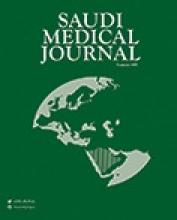Abstract
OBJECTIVE: To determine the prevalence of obesity and overweight among Saudi adolescents, using the 2 most widely used international references.
METHODS: A cross-sectional study conducted towards the end of 2001 on a random sample of third grade intermediate and all 3 grades of secondary school Saudi students of both genders in Al-Khobar area, Eastern Saudi Arabia. The body mass index (BMI) was calculated. The American National Health and Nutrition Examination Survey (NHANES) growth charts, which have been adopted by the World Health Organization (WHO), were used. Student with a BMI of <85th and >95th percentile for age and genders, were defined as overweight and <95th percentile defined as obese. The International Obesity Taskforce (IOTF) age-sex-specific BMI cut-offs reference for defining overweight and obesity was used for comparison.
RESULTS: The sample was 1766 students, comprising 675 males and 1091 females. The mean age was 16.4 + 1.7 years. The prevalence of obesity was higher in male than female students (19.3% versus 11.8%) while a higher proportion of female students than males were overweight (17.2% versus 10.2%). No significant difference was found between the 2 references used to determine the prevalence of obesity and overweight.
CONCLUSION: The high prevalence of overweight and obesity recorded in this study call for prevention programs based on dietary and physical education in schools.
- Copyright: © Saudi Medical Journal
This is an open-access article distributed under the terms of the Creative Commons Attribution-Noncommercial-Share Alike 3.0 Unported, which permits unrestricted use, distribution, and reproduction in any medium, provided the original work is properly cited.






